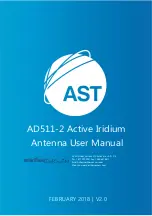
4
AD511-2 Active Iridium Antenna User Manual | Feb 2018 | 2.0
2.
Introduction
Iridium telephones were originally designed to operate with a passive antenna, either an element
attached directly to the handset, or a remote aerial connected with a short length of coaxial cable.
Unfortunately, a signal loss of more than 3dB in a remote antenna’s connecting cable degrades
performance due to attenuation of both the received and transmitted signals. A 3dB loss corresponds to
approximately 10m of RG213U or 3m of RG58U coaxial cable, lengths that clearly restrict the mounting
options for the antenna using standard down-leads.
AD511-2 active Iridium antenna (figure 1 & figure 2) is designed for use with up to 160 meters of coaxial
cable terminated with type ‘N’ connectors, and with coax lengths starting from 27meters – subject to AST
advice.
Designed for harsh environments, the AD511-2 consists of two RHCP dipole antenna housed within a 4mm
thick GRP radome mounted on a common base. One antenna is for signal transmission and one for
reception.
AD511-2 has a linear power amplifier within the base and connected to the transmitting antenna
compensates for signal loss incurred mainly by the connecting cable. Similarly, a low noise amplifier is
attached to the receiving antenna via a low loss interdigital filter to boost the signal sent to the
telephone. The interdigital filter has a bandwidth of 25 MHz centered on the Iridium band designed to
attenuate any out of band interference that may arise, for example from nearby Inmarsat uplinks.
Using manufacturing techniques proven for a range of extremely rugged GPS/DGP active antenna, the
base is milled from aluminium and hard anodised, giving an attractive grey finish, which is mechanically
resilient and resistant to corrosion. The antenna’s mass is 0.8kg.

























